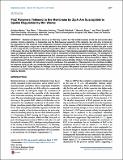Por favor, use este identificador para citar o enlazar a este item:
http://hdl.handle.net/10261/117941COMPARTIR / EXPORTAR:
 SHARE SHARE
 CORE
BASE CORE
BASE
|
|
| Visualizar otros formatos: MARC | Dublin Core | RDF | ORE | MODS | METS | DIDL | DATACITE | |

| Título: | FtsZ polymers tethered to the membrane by ZipA are susceptible to spatial regulation by min waves |
Autor: | Martos, Ariadna CSIC; Raso, A.; Jiménez, Mercedes CSIC ORCID ; Petra sek, Zden ek; Rivas, Germán CSIC ORCID CVN ; Schwille, Petra | Fecha de publicación: | may-2015 | Editor: | Biophysical Society | Citación: | Biophysical Journal Volume 108 May 2015 2371–2383 | Resumen: | Bacterial cell division is driven by an FtsZ ring in which the FtsZ protein localizes at mid-cell and recruits other proteins, forming a divisome. In Escherichia coli, the first molecular assembly of the divisome, the proto-ring, is formed by the association of FtsZ polymers to the cytoplasmic membrane through the membrane-tethering FtsA and ZipA proteins. The MinCDE system plays a major role in the site selection of the division ring because these proteins oscillate from pole to pole in such a way that the concentration of the FtsZ-ring inhibitor, MinC, is minimal at the cell center, thus favoring FtsZ assembly in this region. We show that MinCDE drives the formation of waves of FtsZ polymers associated to bilayers by ZipA, which propagate as antiphase patterns with respect to those of Min as revealed by confocal fluorescence microscopy. The emergence of these FtsZ waves results from the displacement of FtsZ polymers from the vicinity of the membrane by MinCD, which efficiently competes with ZipA for the C-terminal region of FtsZ, a central hub for multiple interactions that are essential for division. The coupling between FtsZ polymers and Min is enhanced at higher surface densities of ZipA or in the presence of crowding agents that favor the accumulation of FtsZ polymers near the membrane. The association of FtsZ polymers to the membrane modifies the response of FtsZ to Min, and comigrating Min-FtsZ waves are observed when FtsZ is free in solution and not attached to the membrane by ZipA. Taken together, our findings show that the dynamic Min patterns modulate the spatial distribution of FtsZ polymers in controlled minimal membranes. We propose that ZipA plays an important role in mid-cell recruitment of FtsZ orchestrated by MinCDE. | Descripción: | 13 p.-7 fig. | Versión del editor: | http://dx.doi.org/ 10.1016/j.bpj.2015.03.031 | URI: | http://hdl.handle.net/10261/117941 | DOI: | 10.1016/j.bpj.2015.03.031 | ISSN: | 0006-3495 | E-ISSN: | 1542-0086 |
| Aparece en las colecciones: | (CIB) Artículos |
Ficheros en este ítem:
| Fichero | Descripción | Tamaño | Formato | |
|---|---|---|---|---|
| Biophysical Journal_G. Rivas_2015.pdf | 4 MB | Adobe PDF |  Visualizar/Abrir |
CORE Recommender
PubMed Central
Citations
16
checked on 10-abr-2024
SCOPUSTM
Citations
27
checked on 21-abr-2024
WEB OF SCIENCETM
Citations
24
checked on 24-feb-2024
Page view(s)
421
checked on 22-abr-2024
Download(s)
440
checked on 22-abr-2024
Google ScholarTM
Check
Altmetric
Altmetric
Artículos relacionados:
NOTA: Los ítems de Digital.CSIC están protegidos por copyright, con todos los derechos reservados, a menos que se indique lo contrario.
